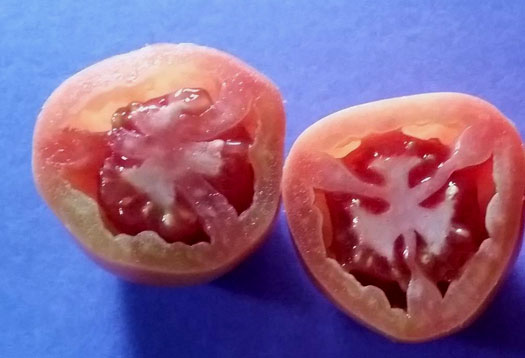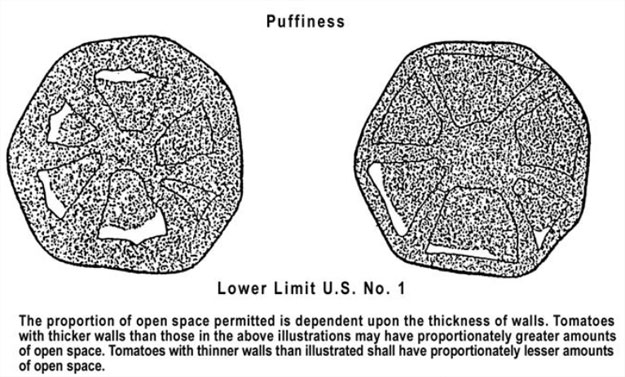Tomatoes that exhibit signs of being puffy may be scored as quality defects. Have you ever picked up a tomato and noticed it felt lighter than other tomatoes in the carton? The surface is usually flattened, appearing as being more rectangular than round in shape. When puffy tomatoes are cut, larger air spaces are found in the cavities (locules) normally occupied by the seed-bearing tissues. Puffy tomatoes will not lead into soft or decayed tomatoes, nor will they become more puffy. Puffy tomatoes occur while growing, due to problems with pollination, extremes such as excessive soil moisture or drought, or by heavy applications of nitrogen.

This tomato is showing the internal symptoms of puffy. You can clearly see the open spaces within the locules. But is the puffy seen here enough to be scored as a defect? The USDA does have specific scoring guidelines for scoring this defect.
Score as: Damage- Open space in 1 or more locules materially detracts from appearance of tomato cut through center at right angles to a line from stem to blossom end.
Score as: Serious damage- Open space in 1 or more locules seriously detracts from appearance of tomato cut through center at right angles to a line from stem to blossom end.
The suspected puffy tomatoes are cut in half, crosswise, to expose the locules. The tomato shown here has open spaces in all three locules, bad enough to say the open spaces seriously detracts from the appearance, thus this tomato should be scored as a serious damage defect, against the 10% tolerance for defects.

The USDA has added a bit on confusion to the scoring guideline by adding a visual aid to assist the inspector in making their determination. This illustration depicts the lower limit allowed before scoring a tomato as being damaged by puffy. In other words, what you see above is allowed, but if the puffiness is slightly worse than what seen above then the tomato is scored as a defect. The tomato section on the left is showing the amount of puffiness allowed in a thick walled tomato and the tomato section on the right depicts the amount of puffiness allowed for a thin walled tomato. As you can see, more than twice the amount of open spaces are allowed on a thick walled tomato versus a thin walled tomato. Confusing? Yes, absolutely, as the image contradicts what is the written scoring guideline, “Open space in 1 or more locules materially detracts from appearance of tomato are scored as a defect.”
So what do inspectors use as their scoring guideline, the written guideline or the image as seen here, as both are found in the U.S. Grade Standards for Tomatoes? Most inspectors that I have worked with use the image shown here as their scoring guideline.

No Comments on “Tomatoes- Puffy”